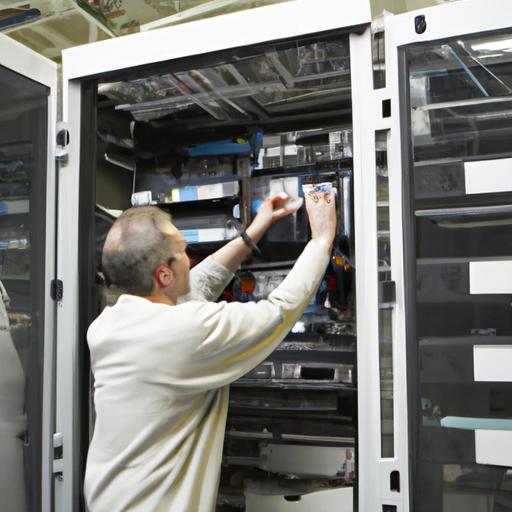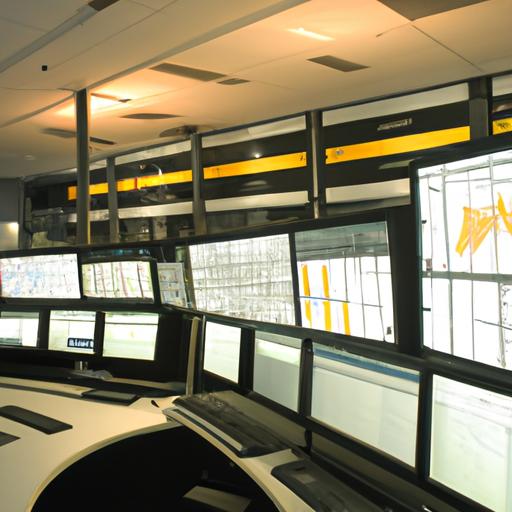If you’re running a business that depends on a data center, you know how important it is to keep things running smoothly. But managing a data center is no easy task. From monitoring and reporting to disaster recovery planning and execution, there are a lot of moving parts to keep track of. That’s where Data Center Operations Management comes in.
Definition of Data Center Operations Management

Data center operations management requires a team of skilled engineers to monitor server performance and ensure efficient operations.
Data Center Operations Management (DCOM) is the process of managing the day-to-day operations of a data center. This includes everything from monitoring server and network performance to ensuring that security protocols are in place and followed. The goal of DCOM is to maintain the availability, reliability, and efficiency of the data center.
Importance of Data Center Operations Management

Regular maintenance is crucial for optimal server performance and uptime in data center operations management.
In today’s digital age, businesses rely on data centers more than ever before. Data centers house the servers, storage devices, and networking equipment that power everything from e-commerce sites to social media platforms. If a data center goes down, it can have a significant impact on a business’s operations, leading to lost revenue and a damaged reputation.
That’s why it’s crucial to have a solid DCOM strategy in place. By proactively managing the data center, businesses can minimize the risk of downtime, improve overall performance, and ensure that critical data is always available.
Key challenges in Data Center Operations Management

Real-time monitoring and reporting are essential in data center operations management to prevent downtime and ensure business continuity.
While DCOM is essential, it’s not without its challenges. Some of the key challenges include:
- Complexity: Data centers are complex environments, with multiple systems and applications running simultaneously. Managing all of these moving parts can be a daunting task.
- Scalability: As businesses grow and their data center needs expand, it can be challenging to scale the infrastructure and processes to keep up with demand.
- Security: With the increasing threat of cyberattacks, data center security is more critical than ever. Managing security protocols and staying up to date with the latest threats can be a full-time job in itself.
Best Practices for Data Center Operations Management
Effective DCOM requires a comprehensive approach that covers all aspects of data center management. Here are some best practices to consider:
Monitoring and Reporting
Monitoring and reporting are critical components of DCOM. By monitoring server and network performance, businesses can detect issues before they become major problems. Regular reporting can also help identify trends and patterns, allowing businesses to make data-driven decisions about infrastructure and resource allocation.
Automation and Orchestration
Automation and orchestration can help streamline data center operations and reduce the risk of human error. By automating routine tasks, businesses can free up staff to focus on more strategic initiatives. Orchestration tools can also help ensure that workflows and processes are executed consistently and efficiently.
Capacity Planning and Optimization
Capacity planning and optimization are essential for ensuring that the data center has the resources it needs to meet business demands. By regularly assessing capacity and usage trends, businesses can make informed decisions about when to scale up or down.
Disaster Recovery Planning and Execution
Disaster recovery planning and execution are critical components of DCOM. By having a solid disaster recovery plan in place, businesses can minimize the impact of unexpected downtime. Regular testing and fine-tuning of the plan can also help ensure that it is effective when it’s needed most.
Security and Compliance Management
Security and compliance management are top priorities for any business that handles sensitive data. By implementing robust security protocols and staying up to date with the latest threats, businesses can minimize the risk of data breaches and other security incidents. Compliance management can also help ensure that the data center meets regulatory requirements.
Vendor Management
Finally, effective vendor management is essential for DCOM. By working closely with vendors to ensure that hardware and software are up to date and fully supported, businesses can minimize the risk of compatibility issues and other problems. Regular vendor assessments can also help ensure that vendors are meeting service level agreements and other contractual obligations.
Trends and Innovations in Data Center Operations Management
As technology continues to evolve, so do the trends and innovations in Data Center Operations Management (DCOM). Here are some of the latest trends and innovations that are shaping the future of DCOM:
Edge computing
Edge computing is a distributed computing paradigm that brings computation and data storage closer to the location where it is needed, reducing latency and improving performance. By placing servers and other computing resources closer to the edge of the network, businesses can process and analyze data in real-time, without having to send it back to a central data center.
Artificial intelligence and machine learning
Artificial intelligence (AI) and machine learning (ML) are becoming increasingly important in DCOM. By analyzing large amounts of data, these technologies can help businesses identify patterns and trends, predict potential issues before they occur, and automate routine tasks.
Internet of Things (IoT)
The Internet of Things (IoT) refers to the network of physical devices, vehicles, buildings, and other items that are embedded with sensors, software, and other technologies that enable them to collect and exchange data. In DCOM, IoT devices can be used to monitor and manage various aspects of the data center, from temperature and humidity to power usage and security.
Renewable energy and sustainability
As businesses become more environmentally conscious, there is a growing trend towards using renewable energy sources to power data centers. This includes solar, wind, and hydroelectric power, as well as energy-efficient infrastructure and cooling systems.
Hybrid cloud and multi-cloud management
Hybrid cloud and multi-cloud management are becoming increasingly popular as businesses look to take advantage of the benefits of both public and private cloud environments. By managing multiple cloud environments, businesses can optimize performance, reduce costs, and improve overall efficiency.
Key Metrics for Data Center Operations Management
When it comes to measuring the success of a Data Center Operations Management strategy, there are several key metrics to consider. These metrics can help businesses identify areas for improvement and track progress over time.
Power usage effectiveness (PUE)
PUE is a measure of how efficiently a data center uses energy. It’s calculated by dividing the total amount of energy used by the data center by the energy used by the IT equipment alone. A lower PUE indicates that the data center is more energy-efficient.
Data center infrastructure efficiency (DCIE)
DCIE is another measure of energy efficiency. It’s calculated by dividing the IT equipment’s power usage by the total power used by the data center’s infrastructure. A higher DCIE indicates that the data center’s infrastructure is more efficient.
Mean time between failures (MTBF)
MTBF is a measure of how long a piece of equipment typically operates before failing. It’s calculated by dividing the total operating time by the number of failures. A higher MTBF indicates that the equipment is more reliable.
Mean time to repair (MTTR)
MTTR is a measure of how quickly a piece of equipment can be repaired after it fails. It’s calculated by dividing the total downtime by the number of repairs. A lower MTTR indicates that equipment can be repaired more quickly, reducing downtime.
Availability and uptime
Availability and uptime are measures of how often the data center is available and functioning correctly. Availability is typically measured as a percentage of uptime over a given period, such as a month or a year. A higher availability percentage indicates that the data center is more reliable and less prone to downtime.
Conclusion
In conclusion, Data Center Operations Management is a critical component of running a successful data center. By implementing best practices, using the right tools and technologies, and staying on top of the latest trends and innovations, businesses can ensure that their data centers are running smoothly and efficiently.
Remember, data centers are complex environments that require constant attention and management. But with the right approach, businesses can minimize downtime, improve performance, and ensure that critical data is always available.
So if you’re running a data center, make sure that you’re prioritizing DCOM. By doing so, you’ll be able to stay ahead of the curve and ensure that your business is always up and running.